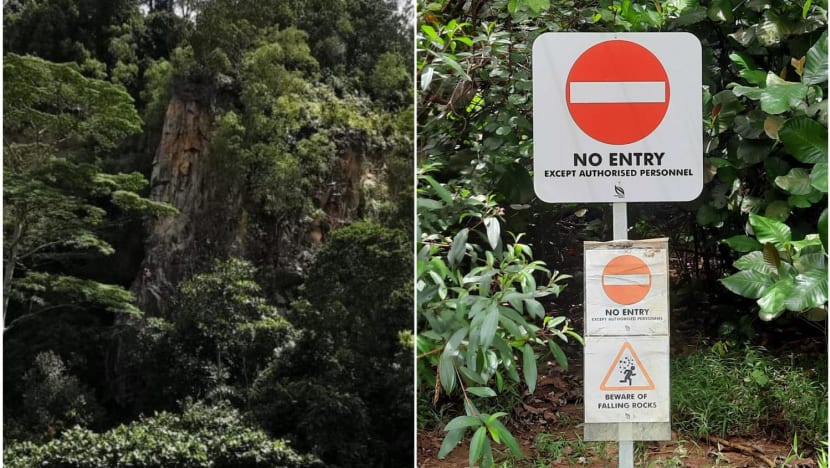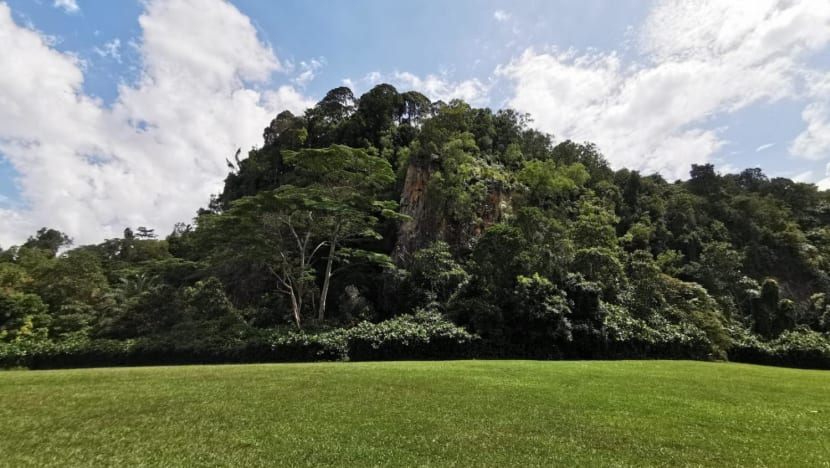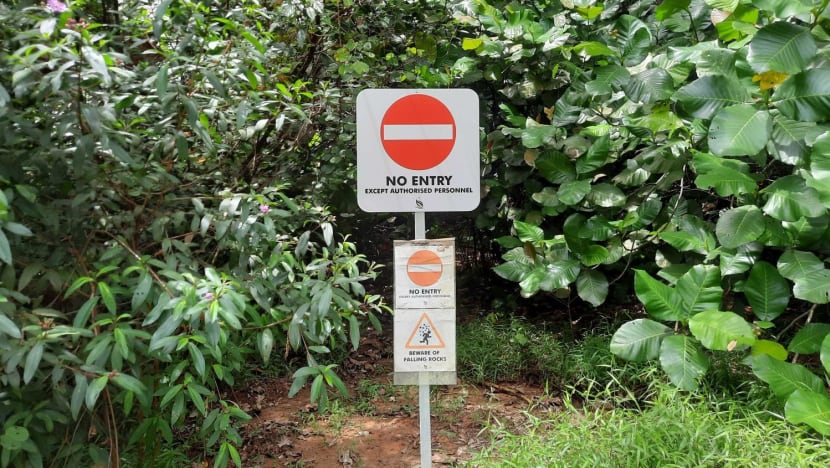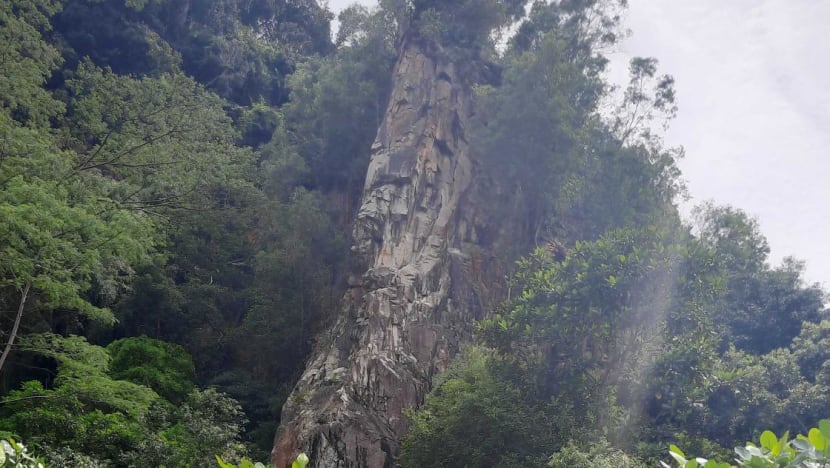Issue of climbing at Dairy Farm Quarry at a standstill after NParks prohibits entry to rock walls
The climbers have formed an organisation and launched a petition to persuade authorities to allow rock climbing at Dairy Farm Quarry - to no avail.

Signs have been put up prohibiting access to the rock walls at Dairy Farm Quarry. (Photos: Yu Kanghao, CNA/Koh Wan Ting)
SINGAPORE: It has been more than a year since signs were put up preventing entry to rock climbing sites at Dairy Farm Quarry, but no resolution is in sight for climbers seeking to scale the only natural rock walls in Singapore.
The former quarry, located to the north of Bukit Timah Nature Reserve, has been the crux of a tussle between National Parks Board (NParks), which says the site is dangerous, and climbers, who argue that the risks can be mitigated.
In February last year, “no entry” signs were placed at entrances to rock surfaces, essentially prohibiting climbers from approaching the site, they told CNA. Along with these were signs that warn parkgoers of falling rocks.
But climbers said they have been scaling Dairy Farm Quarry’s granite walls from as early as the 1980s.
The reasons for the signs are unclear, with climbers saying they heard there was an accident a few months before signs were put up. NParks did not reply to queries about whether an accident had taken place.
Following the prohibitions, climbers have engaged NParks in the hopes of hashing out a compromise but to no avail as the authority has maintained its stand, climbers involved in the matter told CNA.
When CNA visited Dairy Farm Quarry, there were at least five “no entry” signs within the area leading to rock faces. Bolts and anchors that climbers use to attach ropes while scaling the facades were still visible on past established routes.


HOW CLIMBING AT THE QUARRY CAME TO BE
Dairy Farm Quarry is one of a handful of quarries in the area that was previously a source of granite, used in Singapore’s construction sector in the 1900s, according to NParks’ historical review of Bukit Timah Nature Reserve. The quarry ceased operations in the early 1970s.
A decade later, an aspiring climber stumbled upon the site and found that it did not have water at its base unlike other areas, according to Climb Singapore, a climbing guidebook. The book dubs Dairy Farm Quarry as the “only remaining natural climbing area in Singapore” and also noted without elaboration that there were “concerns” that climbing there was illegal.
The pioneer climber, Anthony Seah, introduced Dairy Farm Quarry’s first climbing route in the 1980s.
Climbers have since taken to the quarry, compiling information about routes and approaches on website The Crag over the years. The database records at least 134 routes spanning up to 42m in height with varying levels of difficulty and technical skill required.
NPARKS: DANGER DUE TO RISK OF ROCKFALL
Asked about the signs at Dairy Farm Quarry, NParks’ group director of conservation Lim Liang Jim cited findings from geotechnical consultants who had assessed that the rock faces at Dairy Farm Nature Park “posed some element of risk of rockfall, with attendant danger to people on and below the rock faces”.
“With the findings from the geotechnical assessment, we have been engaging the community of climbers on the safety of climbing at Dairy Farm Quarry.
“While we are aware of the requests for the Dairy Farm Quarry to be made available for outdoor climbing, in view of the risks posed to public safety, we seek the understanding of all visitors to Dairy Farm Nature Park to heed the warning signs and not go off trail to enter the rock face area,” said Mr Lim.
NParks has been engaging geotechnical consultants to carry out risk impact assessments on slopes and rock surface areas under its purview, according to Mr Lim.
“This has been necessary as we have experienced several slope failures which may have been aggravated by severe weather conditions. Rockfalls have also occurred recently at former quarry sites, such as at Bukit Batok Nature Park,” he said.
He added that like Bukit Batok Nature Park, the rock faces at Dairy Farm Quarry were not natural, but a result of past quarrying activity where rock was blasted for granite extraction.
“There have been regular observations of rockfall over the years, and while there are no public trails leading to the Dairy Farm Quarry, for public safety, signs that caution against access and of rockfall have been installed at the base of the rock faces since 2015.”
When approached, the Singapore Sport Climbing and Mountaineering Federation, which regulates and set standards and guidelines for mountaineering activities in Singapore, directed CNA’s queries to NParks.
Its secretary-general Rasip Isnin said that the federation was part of the team engaging NParks on the issue last year and had shared its recommendations with the authority.

CLIMBERS LAUNCH PETITION
Despite the availability of indoor gyms, climbers over the years have taken to Dairy Farm Quarry to experience outdoor climbing in urban Singapore. One such climber, Yu Kanghao, started scaling the walls at Dairy Farm Quarry in July 2018 and was a regular on weekends.
Upon finding access denied, the lawyer said he felt “a little bit of confusion and a large dose of frustration”.
Mr Yu said that he is drawn to Dairy Farm Quarry as it is an outdoor site.
“It's completely different from climbing in the climbing gyms, which we often refer to as climbing on ‘plastic’, because of the material the holds are made of ... Climbing on real rock is much more varied and dynamic,” he said.
“It's a way to commune with nature, in an active sense, because unlike gym routes that are set by someone, outdoors you climb using whatever nature provided. The air in Dairy Farm smells and feels fresher than elsewhere, the outdoor climbing community is warm and welcoming unlike in the gyms where the typical Singaporean standoffish-ness is usually on full display.”
Mr Yu is one of the people behind Rock Climbers Collective (RCC), an organisation registered specifically to engage the authorities over climbing at Dairy Farm Quarry.
RCC’s representative Cheang Qing Xin, a certified rock instructor and climbing veteran, told CNA that the organisation aims to represent climbers’ interest in the matter.
Around a month after the signs were placed, RCC submitted to NParks a 44-page management plan addressing liability and safety issues based on consultations with other agencies and case studies from other sites, such as Yosemite National Park in the US.
RCC also started a petition on website Change.org to garner support for rock climbing to be allowed at Dairy Farm Quarry. The petition states: “We acknowledge that recent incidents may have surfaced issues about safety at the crag, but we believe there is a middle ground where risks can be managed and are ready to work with the relevant authorities to achieve that.”
At the time of publication, more than 2,400 had signed the petition, with most saying that Dairy Farm Quarry was the only natural rock climbing area in Singapore.
RCC and NParks first met last year to discuss the issue, with the climbers' organisation presenting its proposal and feedback from a survey of 500 climbers on measures that can be implemented at Dairy Farm Quarry. A handful of engagement sessions followed, spanning more than a year.
The last session was in August this year, when NParks and their consultants presented the findings of their assessment to a group of climbers, including members of RCC.

CLIMBERS: NPARKS’ STUDY FLAWED
This study, according to RCC representative Mr Cheang, was flawed and lacked input from climbers.
“They used a very engineering perspective to look at the risk management plan in Dairy Farm. (They) did a risk assessment of different areas, but they are not really climbers so they don’t really understand what climbers do in order to mitigate the risks,” he said.
“Rock climbing has always been practised in the quarry. Where there is rock there will be rockfall. This is the nature of climbing on rock and any attempt to reduce or mitigate the risks to zero is futile, as nature is a force that we cannot completely control.”
What NParks has done “clearly defies the spirit of adventure and outdoor sports”, he added.
Climbers also noted that the prohibition might inadvertently lead to people climbing under the radar and failing to share information about possible hazards for fear of being penalised.
One such climber who was seen in the area when CNA visited said that Dairy Farm had “sentimental value” to him as he was one of its pioneer climbers.
The climber, who declined to give his name, said he voluntarily checks on the bolts and anchors at the rock walls and changes them if necessary to ensure they are in good condition. Asked for his views on Dairy Farm Quarry as a climbing site, the man said that it was a good place to expose climbers to climbing outdoors before they progressed to crags overseas.
Those who climb at Dairy Farm Quarry need to know what kind of rock surface they are dealing with, he added. Granite has a smoother surface with angled cracks, so there is a lack of friction for smearing – a move where you press your shoe to the surface of the rock to ascend.
“During the rainy season after heavy rain, we have to see the changes with soil erosion and if the place is good. After a prolonged dry period, if we see falling sand and we know to be careful, it helps us make better decisions. Climb on the safe side, don’t stay on a route with loose rocks,” he said.
The bottom line is that climbers ought to make their own assessments and be responsible for their own actions, he added.
ACCIDENTS LARGELY DUE TO HUMAN ERROR: RCC
Mr Cheang, the founder of rock climbing guide service company Qxadventures, said that while there have been accidents at Dairy Farm Quarry, the majority were due to human error, attributable to the lack of good courses and instructors for climbers.
“Without an organisation that cares for and advocates for the interests of outdoor rock climbers, climbers going outside have largely been left to their own devices and subject to the varying quality of mentorship present among their peers,” he said.
Mr Cheang, who started climbing at Dairy Farm Quarry in the early 2000s, recalled an accident directly linked to rockfall after a climber dislodged a loose rock which then hit his belayer, who controls the safety rope for a climber. The climber in this case did not have enough knowledge to recognise and avoid the loose rocks, he said.
Some of RCC’s proposals include frequently checking the bolts and anchors at the climbing sites to ensure their integrity, having climbers sign a liability form that informs them of the risks involved, and having an evacuation plan in the case of an accident.
But NParks has maintained its stance and Mr Cheang continues to engage the authority.
“I’m sure we will find some ways around it and we can keep it open for people to enjoy. We don’t need to just say, okay it’s closed, no climbing for everyone,” said Mr Cheang.
“It’s just an open space that has a great community and vibe. Singapore has so many indoor climbing gyms, it's just not the same to be outside.”

















